SES San Francisco 2012 Recap
Happy (end of) Monday! Last week, the BCI gang was at SES San Francisco 2012 where we covered 18 sessions, just for you. And I’m not sure if it was the sessions we chose, a shift in interest among marketers, a rebrand move by SES (or all three), but it definitely felt like the sessions were getting into more sophisticated topics on analyzing data and multichannel marketing.
I’m a fan, and think it definitely showcased some of the great things companies are doing out there to elevate the discipline and their brand’s experience.
We heard from Googlers like Avinash Kaushik and Matt Cutts this year. Avinash’s approach to marketing in the digital age, I think, speaks volumes about Google’s stance on how businesses should be approaching their marketing online; that is, look at the big picture.
The idea is to not be so focused on incremental wins in the here and now, but forecast your strategy years from now, and take into account all the opportunities to connect and add value – not just during the big conversion.
The keynote with Avinash on optimization in a digital age revealed a three-prong approach to connecting with your audience:
- Influence: Targeting the right people with the right message.
- Experience: Deliver an amazing experience on all channels.
- Value: The concept of if you give great things, you get great things in return.
Some interesting quips from our live Twitter coverage of that keynote …
On holistic optimization:
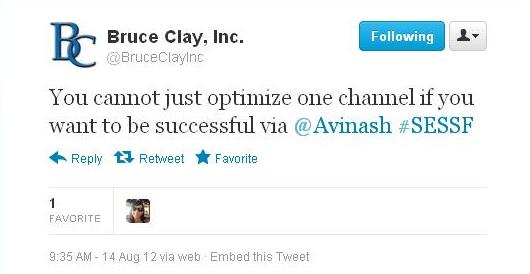
On “intent” marketing:
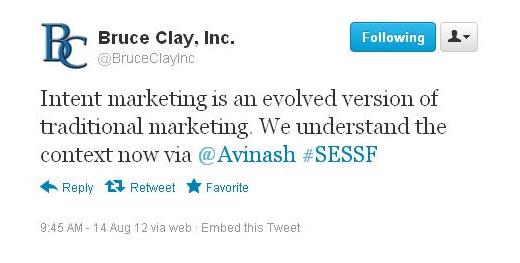
On measuring the right things:
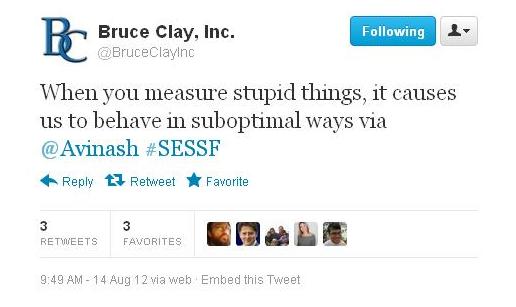
On microconversion opportunities:
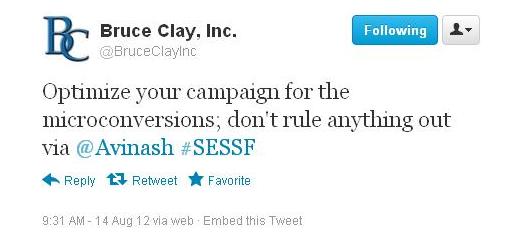
On mobile:
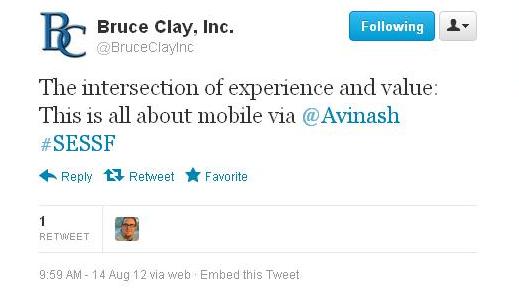
In an unexpected appearance, Day 2 welcomed Matt Cutts and Search Engine Land’s Danny Sullivan for a question-and-answer session led by SES’ Mike Grehan. At one point, they invited Brett Tabke, founder of PubCon, up with them on stage. That stage at that moment was representative of four major voices in the search industry spanning three conference circuits and one big search engine.
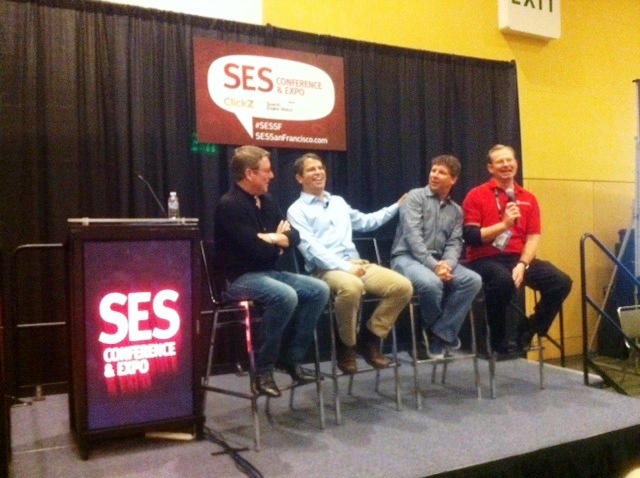
To that end, Virginia Nussey who covered the session commented that SES demonstrated leadership by having all those reps on one stage together:
“You can’t view your brand in a vacuum and pretend that others don’t exist; what SES did at that session was put any competition aside and acknowledge the value others bring to the industry. That’s how they’re carving out their leadership position.”
The sentiment SES showed with that gesture is echoed by Google’s mission and what seems like a refocus of their approach on the SERPs; Matt’s team, once dubbed “search quality” is now “search knowledge.” We gathered that ultimately, that’s what Google is trying to deliver: value through knowledge.
This really makes you think about the kind of content your business is putting out there, and the approach you might want to take, agree?
Multichannel Marketing is Hot, Hot, Hot
It’s no secret that the disciplines in Web marketing are merging and have been for quite some time. Spring-boarding off the holistic marketing concept from Avinash were several sessions that talked multichannel marketing.
The intersection of email, mobile and social marketing is one area where channels work together for an end goal. In this session, as well as others at SES, the talked-about concept was using all channels to gather data and create a unified and personalized message for the individual user. And when it comes to mobile, Jay Jhun reminded us that mobile should not be considered a channel itself, because mobile transcends channels.
And of course, the big idea this year is content marketing. The convergence of search, social and content shows us that just like mobile, content spans channels and includes disciplines such as SEO, social media and much, much more.
And then we get into things like marrying conversion optimization with email marketing. I dropped in on Sundeep Kapur’s session last minute, and was glad I did. Not only did he have some interesting info on email marketing, but I happen to like his presentation style; He was down on the floor, level with the audience, walking up and down the aisle.
I’m a sucker for presenters who try to make the audience feel at ease and part of the conversation. It’s no surprise he did this, since many of his talking points were about communicating with empathy. But I digress …
In his session, he gave lots of tips on using data across channels to personalize the message; but he also reminded email marketers not to forget about the landing page – to the point of using data to personalize the landing page to the individual user for better conversion.
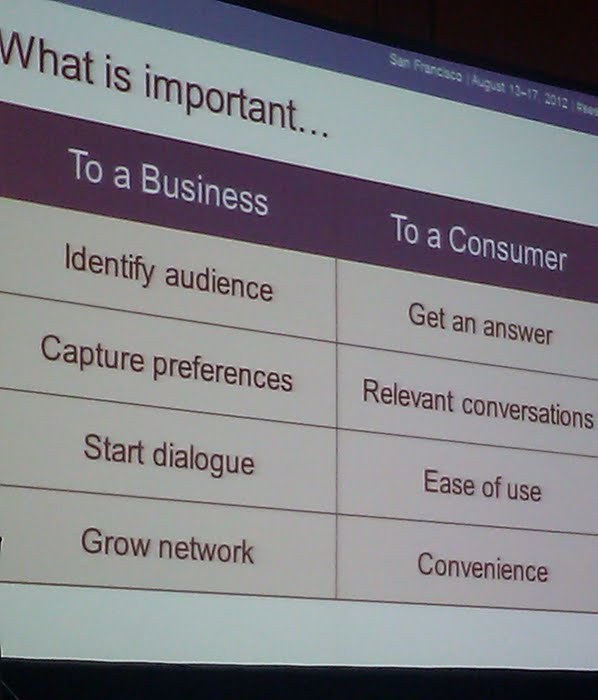
Turning Data into Stories through Context
Making your data work for your business was a big theme this year. From attribution modeling to analytics to helpful tools and more, there was lots of talk about context – something you need to look at to make data meaningful.
In the Web analytics deep dive as well as the introduction to analytics sessions, context (not content) was king. Thom Craver reminded us in his presentation that data is just a bunch of seemingly disconnected numbers without context. Context, he says, is what turns data into information you can use.
The information you can learn from your analytics systems can reveal missed opportunities to touch your audience. One tip Thom gave in his session:
You know people are not going to buy every time. What can they or did they do on your site besides buying that is still valuable? For example, offer a newsletter and measure signups against the cost of buying leads. Or put a value on a download versus printing and mailing a piece of collateral. Measure this by showing how much money you saved. Maybe it’s not about making money; maybe it’s about saving money.
Matt Bailey’s presentation also talked about context, and reminded us if you only report performance, you are not meeting your business goals. From his session:
People assume the information they see when they log into analytics is the most important data. It’s not. It’s generic and meant to work for every business. You must make the software work for your business.
“Cave Man” analytics generates reports like time on site, pageviews, etc. This leads to “Hamster Wheel” analytics — same numbers every month from one report to the next. When people have questions, we don’t have answers.
You can transform your analytics strategy by asking:
- Where did visitors come from?
- What did they see?
- How did they react?
In the world of attribution modeling, we gathered a lot of great information from a couple sessions like the one on attribution in a B2B environment, as well as the one on measuring profit and ROI across channels. The latter presentation welcomed Jamie Smith who shared with us his formula for attribution. From his session:
His company does a 40 percent attribution to first click, 40 percent to last click, and disperses the 20 percent between the other touch points. This is on a keyword level but you can also do this cross-channels.
In that same session, Thomas Bindl shared a couple attribution models with us:
- U shape: First and last touch point gets the highest values. This is the one he recommends.
- Even distribution: Every touch points gets the same value. This is the easiest model to start with. Attributing everything is better than just attributing to the last click.
Another huge theme across sessions this year: segment, segment, segment! The idea here is that you have different groups of users coming to your Web property, all with very different needs and goals. The goal is to understand these

types of groups to help you fuel your marketing strategy. You can learn a lot about your users this way. Use your Web analytics to track these groups and think about what sort of value you can provide to these unique users.
Aside from all the great sessions, we were — as always — in great company with the search marketing community. We exchanged ideas, we laughed, (we drank). To peep some pictures from the show, check out our SES album on Facebook.
Thanks for another great show, SES!

3 Replies to “SES San Francisco 2012 Recap”
Being a young bootstrapping start-up there was not enough money in the boot to get my team there but we certainly do appreciate this article and the coverage especially the snip on Matt Baileys presentation. Thanks and keep up the good work guys!
Thanks for the recap Jessica.
due to cuts in the budget of the department I wasn’t able to assist to the SES in San Francisco this year :-(
This post at least gives me a good idea of what has been going on and keeps me uptodate.
Hey Haro,
That’s the reason we love to provide coverage of the shows, for situations just like yours. Thank you for taking the time to reach out and let us know we are making a difference.
Jessica
LEAVE A REPLY









